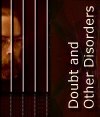What's OCD
Fact I know; and Law I know; but what is this Necessity, save an empty shadow of my own mind's throwing?
Thomas Henry Huxley (1825 - 95), English biologist.
|
WHAT IS OCD?
Obsessive-compulsive disorder (OCD), one of the anxiety disorders, is a potentially disabling condition that can persist throughout a person's life. The individual who suffers from OCD becomes trapped in a pattern of repetitive thoughts and behaviors that are senseless and distressing but extremely difficult to overcome. OCD occurs in a spectrum from mild to severe, but if severe and left untreated, can destroy a person's capacity to function at work, at school, or even in the home.
The following three case histories are typical for those who suffer from obsessive-compulsive disorder--a disorder that can be effectively treated.
-- Isobel is intelligent, but she is failing her first period class in biology because she is either late to class or absent. She gets up at five o'clock, hoping to get to school on time. The next three hours are spent taking a long shower followed by changing clothes repeatedly until it "feels right." She finally packs and repacks her books until they are just right, opens the front door and prepares to walk down the front steps. She goes through a ritual of pausing on each step for a particular length of time. Even though she recognizes her thoughts and behaviors are senseless, she feels compelled to complete her rituals. Once she has completed these rituals, she makes a mad dash for school and arrives when first period is almost over.
-- Meredith's pregnancy was a time of joyous anticipation. If she had moments of trepidation about taking care of a new baby, these times passed quickly. She and her husband proudly brought a beautiful, perfect baby boy home from the hospital. Meredith bathed and fed the baby, comforted him when he was restless, and became a competent young mother. Then the obsessional thoughts began; she feared that she might harm her child. Over and over again she imagined herself stabbing the baby. She busied herself around the house, tried to think of other things, but the distressing thought persisted. She became terrified to use the kitchen knives or her sewing scissors. She knew she did not want to harm her child. Why did she have these distressing, alien thoughts?
During his last year at college, John became aware that he was spending more and more time preparing for classes, but he worked hard and graduated in the top ten percent of his class with a major in accounting. He accepted a position at a prestigious accounting firm in his hometown and began work with high hopes for the future. Within weeks, the firm was having second thoughts about John. Given work that should have taken two or three hours, he was going over and over the figures, checking and rechecking, spending a week or more on a task. He knew it was taking too long to get each job done, but he felt compelled to continue checking. When his probation period was over, the company let him go.
HOW COMMON IS OCD?
For many years, mental health professionals thought of OCD as a rare disease because only a small minority of their patients had the condition. The disorder often went unrecognized because many of those afflicted with OCD, in efforts to keep their repetitive thoughts and behaviors secret, failed to seek treatment. This led to underestimates of the number of people with the illness. However, a survey conducted in the early 1980s by the National Institute of Mental Health (NIMH)--the Federal agency that supports research nationwide on the brain, mental illnesses, and mental health--provided new knowledge about the prevalence of OCD. The NIMH survey showed that OCD affects more than 2 percent of the population, meaning that OCD is more common than such severe mental illnesses as schizophrenia, bipolar disorder, or panic disorder. OCD strikes people of all ethnic groups. Males and females are equally affected. The social and economic costs of OCD were estimated to be $8.4 billion in 1990 (DuPont et al. 1994).
Although OCD symptoms typically begin during the teenage years or early adulthood, recent research shows that some children develop the illness at earlier ages, even during the preschool years. Studies indicate that at least one-third of cases of OCD in adults began in childhood. Suffering from OCD during early stages of a child's development can cause severe problems for the child. It is important that the child receive evaluation and treatment by a knowledgeable clinician to prevent the child from missing important opportunities because of this disorder.
KEY FEATURES OF OCD
These are unwanted ideas or impulses that repeatedly well up in the mind of the person with OCD. Persistent fears that harm may come to self or a loved one, an unreasonable belief that one has a terrible illness, or an excessive need to do things correctly or perfectly, are common. Again and again, the individual experiences a disturbing thought, such as, "My hands may be contaminated--I must wash them"; "I may have left the gas on"; or "I am going to injure my child." These thoughts are intrusive, unpleasant, and produce a high degree of anxiety. Often the obsessions are of a violent or a sexual nature, or concern illness.
In response to their obsessions, most people with OCD resort to repetitive behaviors called compulsions. The most common of these are washing and checking. Other compulsive behaviors include counting (often while performing another compulsive action such as hand washing), repeating, hoarding, and endlessly rearranging objects in an effort to keep them in precise alignment with each other. These behaviors generally are intended to ward off harm to the person with OCD or others. Some people with OCD have regimented rituals while others have rituals that are complex and changing. Performing rituals may give the person with OCD some relief from anxiety, but it is only temporary.
Insight
People with OCD usually have considerable insight into their own problems. Most of the time, they know that their obsessive thoughts are senseless or exaggerated, and that their compulsive behaviors are not really necessary. However, this knowledge is not sufficient to enable them to stop obsessing or the carrying out of rituals.
Resistance
Most people with OCD struggle to banish their unwanted, obsessive thoughts and to prevent themselves from engaging in compulsive behaviors. Many are able to keep their obsessive-compulsive symptoms under control during the hours when they are at work or attending school. But over the months or years, resistance may weaken, and when this happens, OCD may become so severe that time-consuming rituals take over the sufferers' lives, making it impossible for them to continue activities outside the home.
OCD sufferers often attempt to hide their disorder rather than seek help. Often they are successful in concealing their obsessive-compulsive symptoms from friends and coworkers. An unfortunate consequence of this secrecy is that people with OCD usually do not receive professional help until years after the onset of their disease. By that time, they may have learned to work their lives--and family members' lives--around the rituals.
Long-lasting Symptoms
OCD tends to last for years, even decades. The symptoms may become less severe from time-to-time, and there may be long intervals when the symptoms are mild, but for most individuals with OCD, the symptoms are chronic.
WHAT CAUSES OCD?
The old belief that OCD was the result of life experiences has given way before the growing evidence that biological factors are a primary contributor to the disorder. The fact that OCD patients respond well to specific medications that affect the neurotransmitter serotonin suggests the disorder has a neurobiological basis. For that reason, OCD is no longer attributed to attitudes a patient learned in childhood--for example, an inordinate emphasis on cleanliness, or a belief that certain thoughts are dangerous or unacceptable. Instead, the search for causes now focuses on the interaction of neurobiological factors and environmental influences.
OCD is sometimes accompanied by depression, eating disorders, substance abuse disorder, a personality disorder, attention deficit disorder, or another of the anxiety disorders. Co-existing disorders can make OCD more difficult both to diagnose and to treat.
In an effort to identify specific biological factors that may be important in the onset or persistence of OCD, NIMH-supported investigators have used a device called the positron emission tomography (PET) scanner to study the brains of patients with OCD. Several groups of investigators have obtained findings from PET scans suggesting that OCD patients have patterns of brain activity that differ from those of people without mental illness or with some other mental illness. Brain-imaging studies of OCD showing abnormal neurochemical activity in regions known to play a role in certain neurological disorders suggest that these areas may be crucial in the origins of OCD. There is also evidence that medications and cognitive/behavior therapy induce changes in the brain coincident with clinical improvement.
A graphic of Normal and OCD PET scans showing brain activity in the brain of a person with OCD and the brain of a person without OCD. (Source: Lewis Baxter, UCLA Center for Health Sciences, Los Angeles, CA.) In OCD, there is increased activity in a region of the brain called the frontal cortex.)
Symptoms of OCD are seen in association with some other neurological disorders. There is an increased rate of OCD in people with Tourette's syndrome, an illness characterized by involuntary movements and vocalizations. Investigators are currently studying the hypothesis that a genetic relationship exists between OCD and the tic disorders. Another illness that may be linked to OCD is trichotillomania (the repeated urge to pull out scalp hair, eyelashes, or eyebrows). Genetic studies of OCD and other related conditions may enable scientists to pinpoint the molecular basis of these disorders.
DO I HAVE OCD?
A person with OCD has obsessive and compulsive behaviors that are extreme enough to interfere with everyday life. People with OCD should not be confused with a much larger group of individuals who are sometimes called "compulsive" because they hold themselves to a high standard of performance and are perfectionistic and very organized in their work and even in recreational activities. This type of "compulsiveness" often serves a valuable purpose, contributing to a person's self-esteem and success on the job. In that respect, it differs from the life-wrecking obsessions and rituals of the person with OCD.
(OMITTED: A two-part screening test for Obsessive-Compulsive Disorder. Part A requires a yes/no response to 20 questions about repeated thoughts, images, urges, or behaviors. Part B requires response to the frequency of the repeated thoughts, images, urges, or behaviors in Part A. Copyrighted by Wayne K. Goodman, M.D., University of Florida College of Medicine, 1994.)
TREATMENT OF OCD; PROGRESS THROUGH RESEARCH
Clinical and animal research sponsored by NIMH and other scientific organizations has provided information leading to both pharmacologic and behavioral treatments that can benefit the person with OCD. A combination of the two therapies is often an effective method of treatment for most patients. Some individuals respond best to one therapy, some to another.
Clinical trials in recent years have shown that drugs that affect the neurotransmitter serotonin can significantly decrease the symptoms of OCD. Two serotonin reuptake inhibitors (SRIs), clomipramine (Anafranil) and fluoxetine (Prozac), have been approved by the Food and Drug Administration for the treatment of OCD. Other SRIs that have been studied in controlled clinical trials include sertraline (Zoloft) and fluvoxamine (Luvox). Paroxetine (Paxil) is also being used. All these SRIs have proved effective in treatment of OCD. If a patient does not respond well to one SRI, another SRI may give a better response. For patients who are only partially responsive to these medications, research is being conducted on the use of an SRI as the primary medication and one of a variety of medications as an additional drug (an augmenter). Medications are of great help in controlling the symptoms of OCD, but often, if the medication is discontinued, relapse will follow. Most patients can benefit from a combination of medication and behavioral therapy.
Traditional psychotherapy, aimed at helping the patient develop insight into his or her problem, is generally not helpful for OCD. However, a specific behavior therapy approach called "exposure and response prevention" is effective for many people with OCD. In this approach, the patient is deliberately and voluntarily exposed to the feared object or idea, either directly or by imagination, and then is discouraged or prevented from carrying out the usual compulsive response. For example, a compulsive hand washer may be urged to touch an object believed to be contaminated, and then may be denied the opportunity to wash for several hours. When the treatment works well, the patient gradually experiences less anxiety from the obsessive thoughts and becomes able to do without the compulsive actions for extended periods of time.
Studies of behavior therapy for OCD have found it to produce long-lasting benefits. To achieve the best results, a combination of factors is necessary: The therapist should be well trained in the specific method developed; the patient must be highly motivated; and the patient's family must be cooperative. In addition to visits to he therapist, the patient must be faithful in fulfilling "homework assignments." For those patients who complete the course of treatment, the improvements can be significant.
With a combination of pharmacotherapy and behavioral therapy, the majority of OCD patients will be able to function well in both their work and social lives. The ongoing search for causes, together with research on treatment, promises to yield even more hope for people with OCD and their families.
HOW TO GET HELP FOR OCD
If you think that you have OCD, you should seek the help of a mental health professional. Family physicians, clinics, and health maintenance organizations usually can provide treatment or make referrals to mental health centers and specialists. Also, the department of psychiatry at a major medical center or the department of psychology at a university may have specialists who are knowledgeable about the treatment of OCD and are able to provide therapy or recommend another doctor in the area.
WHAT THE FAMILY CAN DO TO HELP
OCD affects not only the sufferer but the whole family. The family often has a difficult time accepting the fact that the person with OCD cannot stop the distressing behavior. Family members may show their anger and resentment, resulting in an increase in the OCD behavior. Or, to keep the peace, they may assist in the rituals or give constant reassurance.
Education about OCD is important for the family. Families can learn specific ways to encourage the person with OCD by supporting the medication regime and the behavior therapy. Self-help books are often a good source of information. Some families seek the help of a family therapist who is trained in the field. Also, in the past few years, many families have joined one of the educational support groups that have been organized throughout the country.
IF YOU HAVE SPECIAL NEEDS
Individuals with OCD are protected under the Americans with Disabilities Act (ADA). Among organizations that offer information related to the ADA are the ADA Information Line at the U.S. Department of Justice, (202) 514-0301, and the Job Accommodation Network (JAN), part of the President's Committee on the Employment of People with Disabilities in the U.S. Department of Labor. JAN is located at West Virginia University, 809 Allen Hall, P.O. Box 6122, Morgantown, WV 26506, telephone (800) 526-7234 (voice or TDD), (800) 526-4698 (in West Virginia).
The Pharmaceutical Manufacturers Association publishes a directory of indigent programs for those who cannot afford medications. Physicians can request a copy of the guide by calling (800) PMA-INFO.
FOR FURTHER INFORMATION
For further information on OCD, its treatment, and how to get help, you may wish to contact the following organizations:
Anxiety Disorders Association of America 6000 Executive Boulevard, Suite 513 Rockville, MD 20852 Telephone 301-231-9350
-- Makes referrals to professional members and to support groups. Has a catalog of available brochures, books, and audiovisuals.
Association for Advancement of Behavior Therapy 305 Seventh Avenue New York, NY 10001 Telephone 212-647-1890
-- Membership listing of mental health professionals focusing in behavior therapy.
Dean Foundation Obsessive Compulsive Information Center 8000 Excelsior Drive, Suite 302 Madison, WI 53717-1914 Telephone 608-836-8070
-- Computer data base of over 4,000 references updated daily. Computer searches done for nominal fee. No charge for quick reference questions. Maintains physician referral and support group lists.
Obsessive Compulsive Foundation P.O. Box 70 Milford, CT 06460 Telephone 203-878-5669
-- Offers free or at minimal cost brochures for individuals with the disorder and their families. In addition, videotapes and books are available. A bimonthly newsletter goes to members who pay an annual membership fee of $30.00. Has over 250 support groups nationwide.
Tourette Syndrome Association, Inc. 42-40 Bell Boulevard New York, NY 11361-2874 Telephone 718-224-2999
-- Publications, videotapes, and films available at minimal cost. Newsletter goes to members who pay an annual fee of $35.00. Books Suggested for Further Reading
Baer, L. Getting Control. Overcoming Your Obsessions and Compulsions. Boston: Little, Brown & Co., 1991.
Foster, C.H. Polly's Magic Games: A Child's View of Obsessive- Compulsive Disorder. Ellsworth, ME: Dilligaf Publishing, 1994.
Greist, J.H. Obsessive Compulsive Disorder: A Guide. Madison, WI:Obsessive Compulsive Disorder Information Center. Rev. ed., 1992. (Thorough discussion of pharmacotherapy and behavior therapy)
Johnston, H.F. Obsessive Compulsive Disorder in Children and Adolescents: A Guide. Madison, WI: Child Psychopharmacology Information Center, 1993.
Livingston, B. Learning to Live with Obsessive Compulsive Disorder. Milford, CT: OCD Foundation, 1989. (Written for the families of those with OCD)
Rapoport, J.L. The Boy Who Couldn't Stop Washing: The Experience and Treatment of Obsessive-Compulsive Disorder. New York: E.P. Dutton, 1989.
Videotape
The Touching Tree. Jim Callner, writer/director, Awareness films. Distributed by the O.C.D. Foundation, Inc., Milford, CT. (About a child with OCD)
REFERENCES
DuPont, R.L.; Rice, D.P.; Shiraki, S.; and Rowland C. Economic Costs of Obsessive Compulsive Disorder. Unpublished, 1994.
Jenike, M.A. Obsessive-Compulsive Disorder: Efficacy of Specific Treatments as Assessed by Controlled Trials. Psychopharmacology Bulletin 29:4:487-499, 1993.
Jenike, M.A. Managing the Patient with Treatment-Resistant Obsessive Compulsive Disorder: Current Strategies. Journal of Clinical Psychiatry 55:3 (suppl):11-17, 1994.
Leonard, H.L.; Swedo, S.E.; Lenane, M.C.; Rettew, D.C.; Hamburger, S.D.; Bartko, J.J.; and Rapoport, J.L. A 2- to 7-Year Follow-up Study of 54 Obsessive-Compulsive Children and Adolescents. Archives of General Psychiatry 50:429-439, 1993.
March, J.S.; Mulle, K.; and Herbel, B. Behavioral Psychotherapy for Children and Adolescents with Obsessive-Compulsive Disorder: An Open Trial of a New Protocol-Driven Treatment Package. Journal of the American Academy of Child and Adolescent Psychiatry 33:3:333-341, 1994.
Pato, M.T.; Zohar-Kadouch, R.; Zohar, J.; and Murphy, D.L. Return of Symptoms after Discontinuation of Clomipramine in Patients with Obsessive Compulsive Disorder. American Journal of Psychiatry 145:1521-1525, 1988.
Swedo, S.E, and Leonard, H.L. Childhood Movement Disorders and Obsessive Compulsive Disorder. Journal of Clinical Psychiatry 55:3 (suppl):32-37, 1994.
MESSAGE FROM THE NATIONAL INSTITUTE OF MENTAL HEALTH
Research conducted and supported by the National Institute of Mental Health (NIMH) brings hope to millions of people who suffer from mental illness and to their families and friends. In many years of work with animals as well as human subjects, researchers have advanced our understanding of the brain and vastly expanded the capability of mental health professionals to diagnose, treat, and prevent mental and brain disorders.
Now, in the 1990s, which the President and Congress have declared "The Decade of the Brain," we stand at the threshold of a new era in brain and behavioral sciences. Through research, we will learn even more about mental disorders such as depression, manic-depressive illness, schizophrenia, panic disorder, and obsessive-compulsive disorder. And we will be able to use this knowledge to develop new therapies that can help more people overcome mental illness.
The National Institute of Mental Health is part of the National Institutes of Health (NIH), the Federal Government's primary agency for biomedical and behavioral research. NIH is a component of the U.S. Department of Health and Human Services.
Material appearing in this brochure is in the public domain except where noted and may be reproduced or copied without permission from the Institute. Citation of the source is appreciated. Portions that are copyrighted may be reproduced only upon permission of the copyright holder.
Acknowledgments
This brochure is a revision by Margaret Strock, staff member in the Information Resources and Inquiries Branch, Office of Scientific Information (OSI), National Institute of Mental Health (NIMH) of a publication originally written by Mary Lynn Hendrix, OSI. Expert assistance was provided by Henrietta Leonard, MD, and Jack Maser, PhD, NIMH staff members; Robert L. DuPont, MD, The Institute for Behavior and Health; Wayne Goodman, MD, University of Florida College of Medicine; and James Broatch, Obsessive Compulsive Foundation, Inc.
U.S. Department of Health and Human Services Public Health Service
National Institutes of Health National Institute of Mental Health
NIH Publication No. 94-3755 Printed 1994
Bulk sales (Stock No. 017-024-01540-7) by the U.S. Government Printing Office, Superintendent of Documents, Mail Stop: SSOP, Washington, DC 20402-9328.
I am not a doctor, therapist or professional in the treatment of OCD. This site reflects my experience and my opinions only, unless otherwise stated. I am not responsible for the content of links I may point to or any content or advertising in HealthyPlace.com other then my own.
Always consult a trained mental health professional before making any decision regarding treatment choice or changes in your treatment. Never discontinue treatment or medication without first consulting your physician, clinician or therapist.
Content of Doubt and Other Disorders
copyright ©1996-2002 All Rights Reserved
next: OCD, Obsessive-Compulsive Disorder Part I
~ ocd library articles
~ all ocd related disorders articles
APA Reference
Tracy, N.
(2009, January 8). What's OCD, HealthyPlace. Retrieved
on 2026, January 13 from https://www.healthyplace.com/ocd-related-disorders/articles/what-is-ocd



